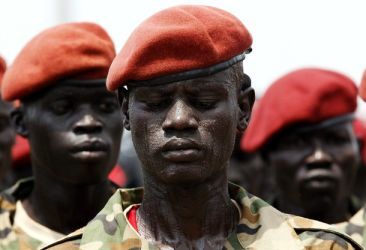South Sudan security sector requires reform, report
June 30, 2012 (JUBA) – The Republic of South Sudan still needs to adopt reforms, which in the long run, will play a crucial role in addressing security challenges the country is faced with, the Swiss-based Small Arms Survey said in recent report.

The document, obtained by Sudan Tribune, gives an overview of the external and internal threats facing South Sudan government as of early 2012, clearly outlining the challenges facing the security forces categorised in terms of location and geography.
Most of the country’s security threats, it says, are “conventional, insurgent, and internal security threats,” mainly emanating from border conflict with the Government of Sudan, militia and proxy forces, inter and intra-ethnic fighting and security forces cohesion.
“Though substantial security reform plans are in motion, detailed, strategic security and defense reviews are needed as soon as possible to provide risk assessments of existing initiatives. Such reviews would probably prompt urgent modification of current plans,” the paper, authored by John A. Snowden, partly reads.
Despite what it described as “poor coordination,” among South Sudan security forces, the latter is also credited having reportedly passed key national internal security tests by demonstrating extraordinary robustness under tremendous pressure, especially during the 2010 elections, the January 2011 referendum and the independence celebrations held six months later.
Currently, Small Arms Survey notes, the external and internal security challenges facing the world’s newest nation prevent the possibility of a “robust thorough security sector reform.”
“Piecemeal reforms and transformation efforts over the last six years have, in some ways, weakened the security forces’ ability to respond to threats, which will remain their primary objective for the short term, at least,” it says.
The 56-page document also analyses the development of security decision-making structures and the evolution of the security forces, in particular the South Sudan army (SPLA) and South Sudan Police Service (SSPS), with specific focus on organisational and conceptual evolution, strength and composition, budgets, and personnel and equipment accountability.
However, while looking at the role of other organised forces such as South Sudan Prisons Service and South Sudan Wildlife Service, the Small Arms Survey says the two “reserve” forces still suffer from poor infrastructure, overcrowding, and unskilled prison officers.
“While progress has been made since 2007 to address these challenges and implement sustainable reforms, this has been largely initiated and sustained by international partners’ funding,” notes the Working Paper.
A recent Human Rights Watch (HRW) exposed the problem within South Sudan prisons, reportedly characterized by flawed processes, unlawful detentions, and dire conditions requiring the urgent need to improve the new nation’s fledgling justice system.
Alison Magaya, South Sudan’s Interior minister described the HRW findings as “not objective” and outlined a series of measures, which he said are in the making to improve the situation within the country’s prisons.
Meanwhile, Small Arms Survey recommends that large-scale Disarmament, Demobilization and Reintegration (DDR) be carried out to reduce security-related spending (and particularly defence costs). It recommends up to 150,000 personnel.
It also urges South Sudan government to adopt operational-level planning and implementation in all security forces, which is reportedly still lacking within the current mindset of the SPLA.
“Strategic and policy-related objectives occasionally translate to tactical action, but always with a focus on the attrition of opposing forces, which is invariably the most costly option,” it says.
“A doctrinal shift towards the employment of key elements of operational art is likely to lead to greater military effectiveness and accelerate the reform process.”
(ST)
